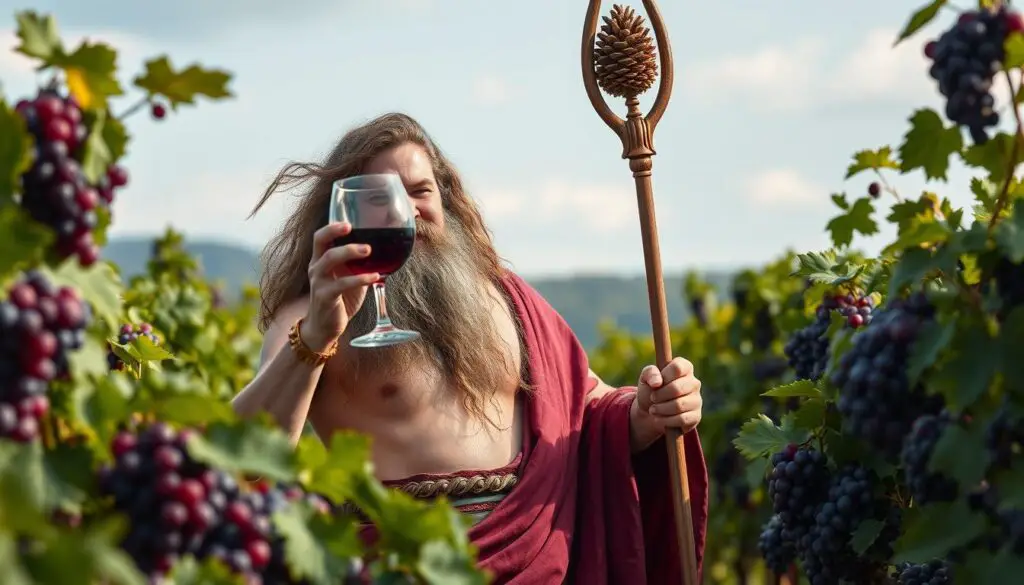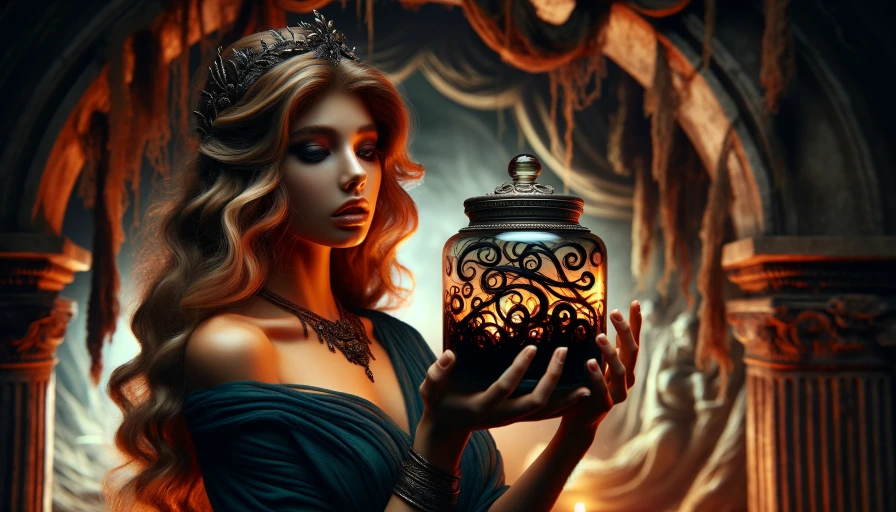In the rich tapestry of ancient Greek mythology, Dionysus, also known as Bacchus, stands out as a captivating and complex figure.
As the Greek god of wine, vegetation, fertility, festivity, ritual madness, religious ecstasy, and theater, Dionysus held a prominent place among the Twelve Olympians, wielding a profound influence on the cultural and religious landscape of the ancient Greek world.
Dionysus’ origins are shrouded in mystery, with some sources describing him as a Thracian deity, while others claim he was a purely Greek god.
Regardless of his exact birthplace, the myth of his divine lineage is captivating, as he was believed to be the son of the mighty Zeus and the mortal princess Semele.
This unique dual heritage, with both divine and human elements, contributed to Dionysus’ multifaceted nature and the enduring fascination with his cult.
Beyond his celestial origins, Dionysus’ odyssey took him on a remarkable journey, from the shores of Greece to the distant lands of Turkey and Asia.
His encounters with various peoples during these travels were instrumental in the dissemination of his cult and the expansion of his influence, which ultimately led to the establishment of the Dionysian Mysteries – secretive rituals that offered participants a transformative experience through dance, music, and wine consumption.
Key Takeaways
- Dionysus was a complex and enigmatic figure in ancient Greek mythology, known as the god of wine, ecstasy, theater, and revelry.
- His origins are uncertain, with some sources describing him as Thracian and others as Greek, but he was believed to be the son of Zeus and the mortal princess Semele.
- Dionysus’ cult was associated with the performance of sacred dramas, which played a significant role in the development of theater in Western culture.
- The Dionysian Mysteries were secret rituals that offered participants a transformative experience through dance, music, and wine consumption.
- Dionysus’ influence extended to various aspects of ancient Greek culture, including art, literature, and philosophy, leaving a lasting impact on the cultural and artistic heritage of the time.
Origins and Etymology of Dionysus
The origins of Dionysus, the Greek god of wine, revelry, and ecstasy, can be traced back to the Mycenaean era.
The earliest written records of his worship come from Mycenaean Greece, specifically from the Palace of Nestor in Pylos, dating back to around 1300 BC.
This suggests that the worship of Dionysus was already well-established during the Mycenaean period.
Mycenaean Origins and Linear B Evidence
The name Dionysus itself is derived from the Mycenaean Greek form di-wo-nu-so, which points to an original *Dios-nysos, meaning “the son of Zeus.”
The dio- prefix is associated with Zeus, the king of the gods, while the second element -nūsos is of uncertain origin, though it may be linked to Mount Nysa, the mythological birthplace of the god.
The appearance of Dionysus on a Linear B tablet from the 13th century BCE further confirms his presence in the Mycenaean pantheon.
This early evidence indicates that the worship of Dionysus was deeply rooted in the cultural and religious traditions of ancient Greece, predating the classical period by several centuries.
Dios-nysos: The “Son of Zeus”
The etymology of Dionysus’s name provides insights into his divine origins and relationship with the king of the gods, Zeus.
The Dios-nysos or “son of Zeus” designation suggests that Dionysus was viewed as a deity with a close connection to the supreme god of the Greek pantheon.
This association with Zeus likely contributed to Dionysus’s prominence and influence in the Mycenaean and classical Greek world.
Dual Nature: God of Ecstasy and Ritual Madness
Dionysus, the Greek god of wine and revelry, possessed a complex dual nature. On one hand, he was the embodiment of fertility, joy, and the liberating power of nature.
But he also represented the dangerous realm of ritual ecstasy and madness.
His devoted cult followers, known as maenads or bacchantes, would often enter frenzied states of ecstasy during his festivals.
These wild rituals involved intense dancing, drinking, and even the ritual tearing apart of living victims.
Dionysus symbolized the subversive and untamed forces within the natural world, freeing his followers from the constraints of self-conscious fear and care.
His followers sought to experience a profound spiritual transformation through their surrender to desire, raw emotion, and the sacred savagery found in the Dionysian rites.
The dual nature of Dionysus, manifesting both the joyful and the terrifying, reflects the complex and contradictory aspects of human nature itself.
His legacy continues to captivate and challenge, reminding us of the power and peril inherent in the ecstatic embrace of the primal forces that lie within us all.
The instances of Dionysian madness causing violent acts are well-documented, such as the followers dismembering Pentheus, the tragic fate of Orpheus, and the killing of Ikarios by shepherds.
This duality of wine, representing both liberation and the potential for violence, is a central aspect of Dionysus’s mythos.
The text emphasizes the importance of finding safe outlets for primal energy to avoid such violent outbursts.
Dionysian spirituality is depicted as a surrender to desire, passion, and savagery, contrasting with the teachings of detachment found in other traditions.
The Romantic concept of the sublime is also linked to Dionysus, highlighting nature’s incomprehensible magnificence and brutality.
The Twice-Born God: Birth and Extraordinary Origins
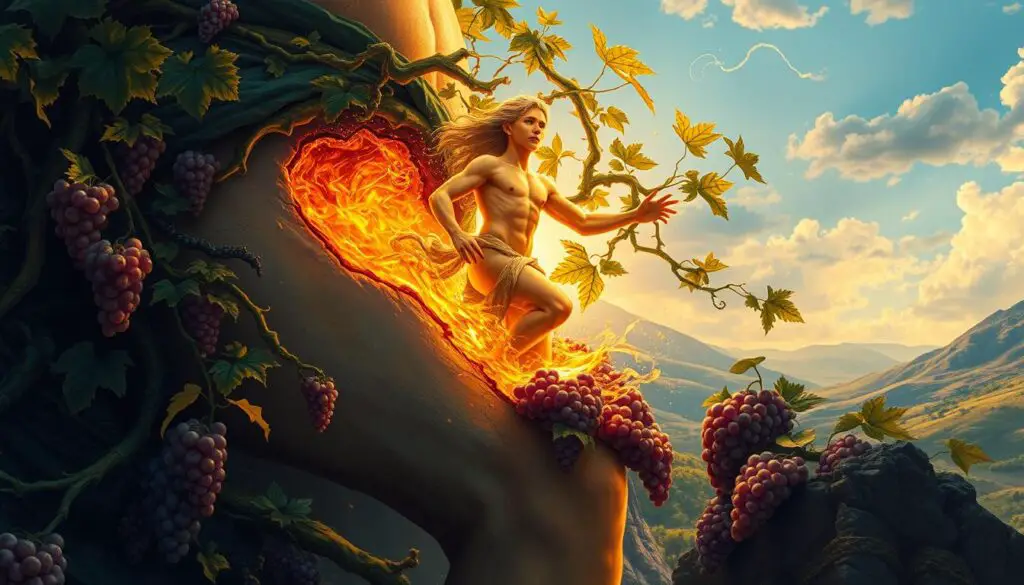
In the captivating world of Greek mythology, Dionysus, also known as the “twice-born” god, was born extraordinarily.
According to the legends, Dionysus was the son of the mighty Zeus and the mortal princess Semele.
This divine union, however, was not without its complications, as Hera, the jealous wife of Zeus, sought to interfere.
The tale goes that Hera, upon discovering Zeus’s affair with Semele, devised a cunning plan.
She persuaded the mortal woman to demand that Zeus appear before her in all his divine glory.
Tragically, Semele’s request proved fatal, as the sheer power of Zeus’s true form consumed the fragile mortal, leading to her untimely demise.
Rebirth from Zeus’s Thigh
Yet, the story of Dionysus does not end there. In a remarkable act of paternal love, Zeus saved the unborn child, sewing the infant Dionysus into his thigh, where the god gestated until he was ready to be born.
This extraordinary “twice-born” nature of Dionysus, emerging first from Semele and then from Zeus’s thigh, has captivated the imagination of ancient and modern audiences alike.
The rebirth of Dionysus symbolizes the cyclical nature of life, death, and renewal, a theme that is deeply woven into the fabric of Greek mythology and the worship of this enigmatic deity.
The twice-born god’s extraordinary origins have become a hallmark of his unique and captivating legacy.
Wanderings and Adventures of Dionysus
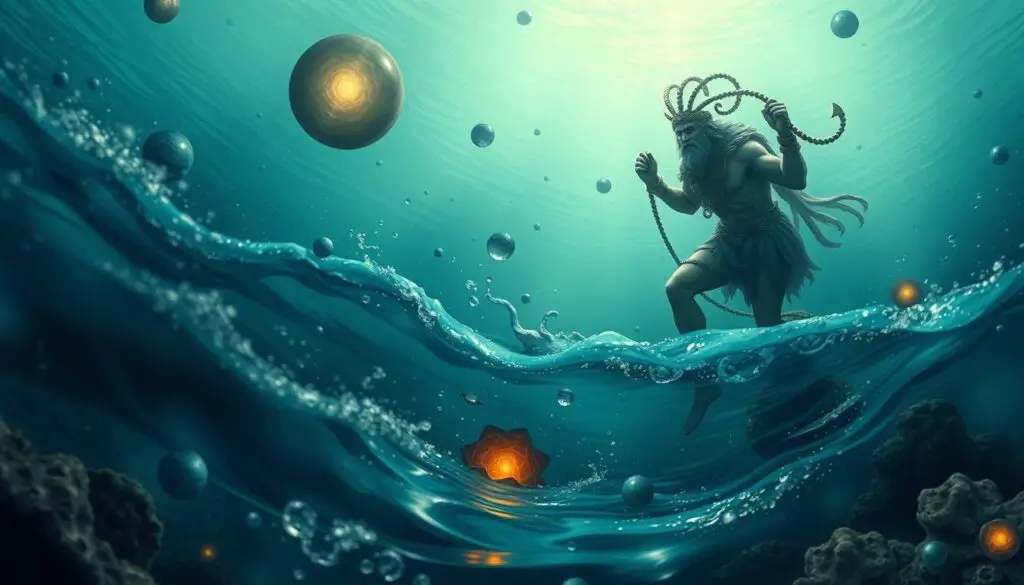
After his extraordinary birth, the Greek god Dionysus embarked on a series of wanderings and adventures, traveling far beyond the confines of Greece.
His journey took him through the vast lands of Asia and India, where he spread the gift of wine and introduced his ecstatic dances and revelrous rituals to various peoples.
Journey Through Asia and India
Dionysus ventured deep into Asia, teaching men the secrets of cultivating vines and the mysteries of his cult.
He was welcomed in many lands, but upon returning to his own country of Thebes, he faced opposition and conflict.
Even when pirates mistook him for a wealthy young man, Dionysus’s supernatural power proved too strong, as the ropes refused to hold him and the ship became overgrown with vines.
Dionysus’s adventures continued as he journeyed to India, where he waged a war against the Argives and sought refuge with the sea goddess Thetis when chased by the king of Thrace, Lycurgus, who opposed the god’s new religion.
Conquering with Wine and Dance
Rather than relying on weapons and war, Dionysus conquered foreign lands through the power of wine and dance.
His ecstatic rituals and revelrous festivities captivated the hearts and minds of the people he encountered, demonstrating his dual nature as both a divine and subversive force.
Dionysus’s adventures were marked by his ability to transform his followers, sometimes driving them to madness, as seen in the tragic fate of King Pentheus of Thebes, who refused to recognize the god’s divinity.
who was Dionysus: The God of Theater and Festivals
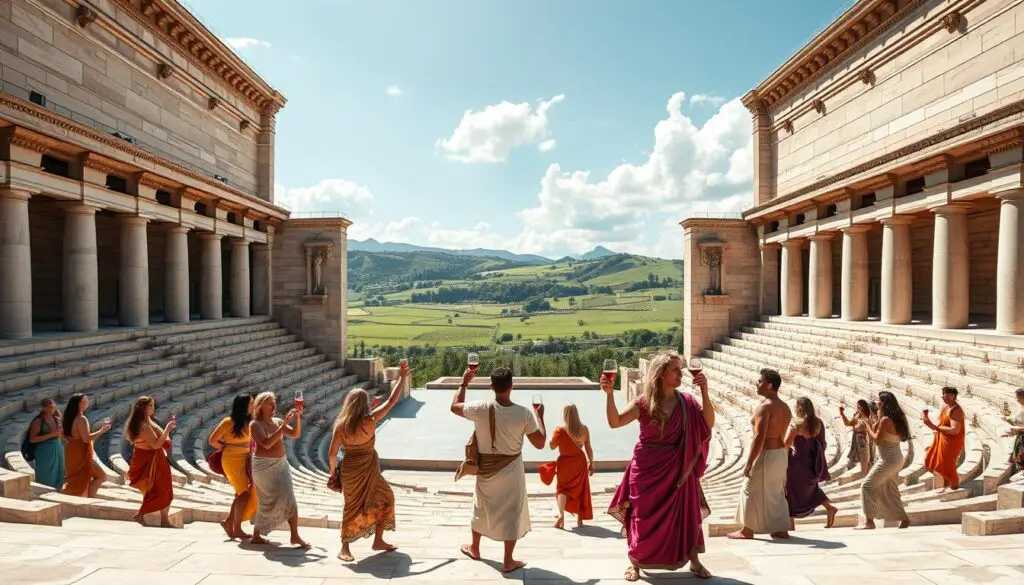
In the pantheon of ancient Greek gods, Dionysus held a special place as the deity closely associated with the development of theater.
His legendary festivals, such as the Lenaea and the Great (or City) Dionysia in Athens, were the driving force behind the emergence of tragedy and comedy in Western culture.
The religious celebrations honoring Dionysus featured the performance of sacred dramas enacting his myths and legends.
These festivals were not mere entertainment, but rather rituals that connected the mortal world to the divine.
Dionysus was honored in lyric poems called dithyrambs, and his cult had a profound impact on art and literature.
- Dionysus was the 12th and youngest god of the 12 Olympian gods in ancient Greek mythology.
- The earliest written records of Dionysus’s worship date back to around 1300 BC in Mycenaean Greece.
- Wine was considered a symbolic incarnation of Dionysus on earth, with the belief that Zeus sent Dionysus to teach mortals how to make and drink wine.
The Theatre of Dionysus at the foot of the Acropolis of Athens, dedicated to the god, had a capacity of up to 17,000 seats and is regarded as the first theater ever built in the world.
This ancient venue hosted a variety of dramatic performances, including tragic plays, satyr plays, and dithyrambic contests, as well as comedies during the Lenaia festival.
Dionysus’s enduring legacy is evident in the fact that the names “Dennis” and “Denise” are believed to be derived from the god’s name, highlighting his profound influence on Western culture.
His connection to the arts, revelry, and the cycles of life and death have made Dionysus a complex and multifaceted figure in the pantheon of ancient Greek deities.
The Bacchic Cult and Wild Revelry
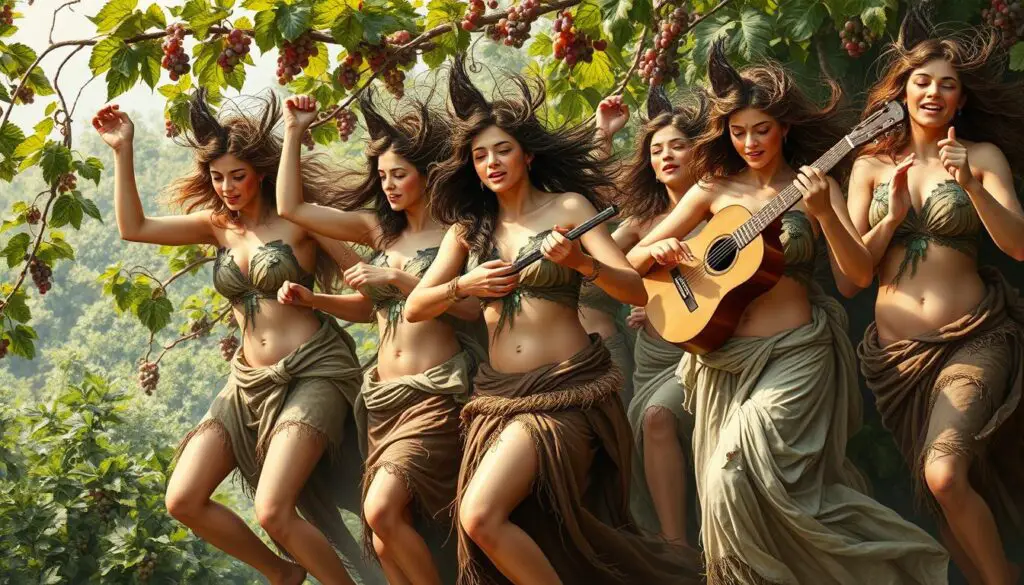
The worship of Dionysus, the Greek god of wine and revelry, often took the form of wild, ecstatic rites known as the Bacchanalia in Rome or the Dionysia in Greece.
These festivals were marked by the participation of the maenads, female followers of Dionysus who would enter frenzied states of ecstasy, engaging in rituals that included dancing, drinking, and even the ritual dismemberment of living victims.
Bacchanalia and Ecstatic Rites
The Bacchanalia festivals were known for their wild revelry, which included excessive drinking, dancing, and ecstatic celebrations.
These events were a reflection of Dionysus’s association with liberation, pleasure, and the unbridled indulgence of the senses.
Maenads and Dionysus’s Entourage
- Dionysus’s entourage also included other spirits of fertility, such as satyrs and sileni, as well as the phallus, which was prominently featured in his rituals.
- The maenads, or female followers of Dionysus, were known for their frenzied worship, engaging in rituals that often involved the ritual dismemberment of living victims.
- These bacchic cult celebrations and the wild, ecstatic rites of the maenads were a testament to Dionysus’s dual nature as a god of both pleasure and ritual madness.
The bacchic cult and its bacchanalia festivities played a significant role in the worship and celebration of Dionysus, the Greek god of wine and revelry.
Myths of Punishment and Retribution

In Greek mythology, the stories of punishment and retribution were central to the tales of the god Dionysus.
Known for his dual nature as the deity of wine, revelry, and ritual madness, Dionysus was also renowned for his severe punishment of those who dared to defy his divinity or oppose his cult.
The Fate of King Lycurgus
One such tale of divine retribution involves the story of King Lycurgus of Thrace.
Lycurgus, a mortal ruler, opposed the worship of Dionysus and imprisoned the god’s followers.
Enraged by this affront, Dionysus drove Lycurgus into a fit of madness, leading the king to attack his own family, believing them to be vines.
Ultimately, Lycurgus met a grisly fate, being torn apart by wild horses for his defiance of the god.
The Brutal Death of Pentheus
Another striking example of Dionysus’s wrath is the story of King Pentheus of Thebes. Pentheus, Dionysus’s cousin, rejected the god’s divinity and attempted to spy on the Bacchic rites performed by the Maenads, Dionysus’s devoted female followers.
Infuriated by Pentheus’s disrespect, Dionysus incited the Maenads, including Pentheus’s mother, Agave, to brutally tear the king apart, a gruesome end for the mortal who dared to challenge the god’s authority.
These myths of punishment and retribution illustrate the profound respect and reverence that ancient Greeks held for the powerful and capricious Dionysus, a deity whose divine wrath could bring about devastating consequences for those who crossed him.
Mysteries, Rites, and Secret Cults
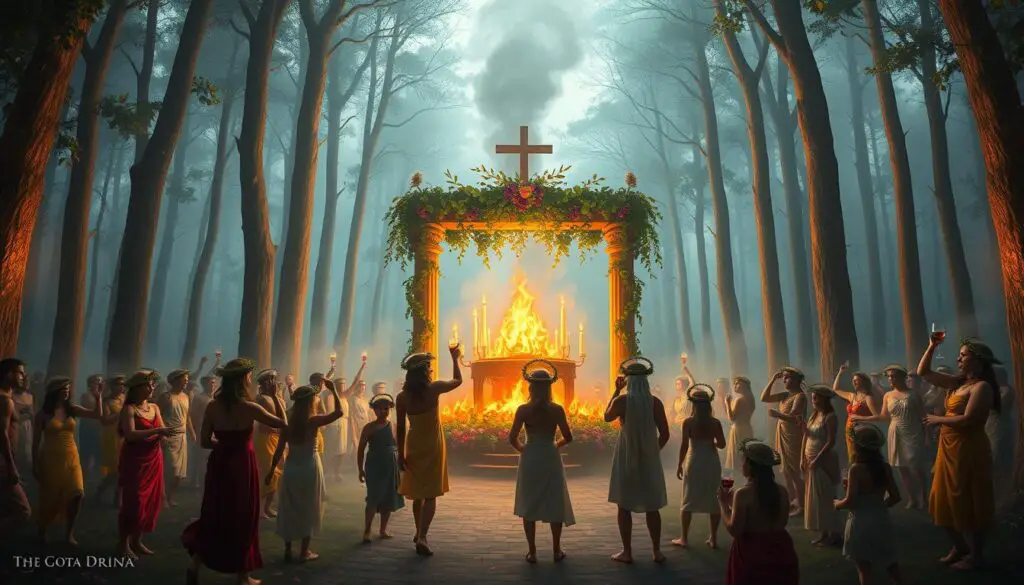
Beyond the public festivals and celebrations, the worship of Dionysus also involved a series of exclusive mysteries and secret rituals known as the Dionysian Mysteries.
These clandestine rites were open only to initiates – those who had undergone a process of initiation and been granted access to the inner sanctum of the cult.
The Dionysian Mysteries were believed to offer participants a direct connection to the divine, allowing them to experience ecstatic states and altered forms of consciousness.
These rites shared similarities with the mysteries associated with other deities like Demeter, Isis, and Mithras, all of which promised spiritual enlightenment and a deeper understanding of the cosmos.
The popularity of the Dionysian secret cults grew over time, attracting a diverse following that included marginalized groups like slaves, outlaws, and foreigners.
The rituals provided a means of escaping societal constraints and tapping into a more primal, visceral realm of existence.
The Dionysian Mysteries involved trance induction through a variety of techniques, including the use of intoxicants, spirit invocations, drumming, dancing, and communal ceremonies.
These practices were designed to facilitate a heightened state of consciousness and a deeper communion with the divine.
Despite their secretive nature, the Dionysian Mysteries have left a lasting impact on ancient Greek and Roman culture.
The cult’s influence can be seen in the enduring symbolism and iconography associated with Dionysus, as well as the ongoing fascination with the mysterious and transformative power of the god’s rites.
Iconography and Symbolism of Dionysus
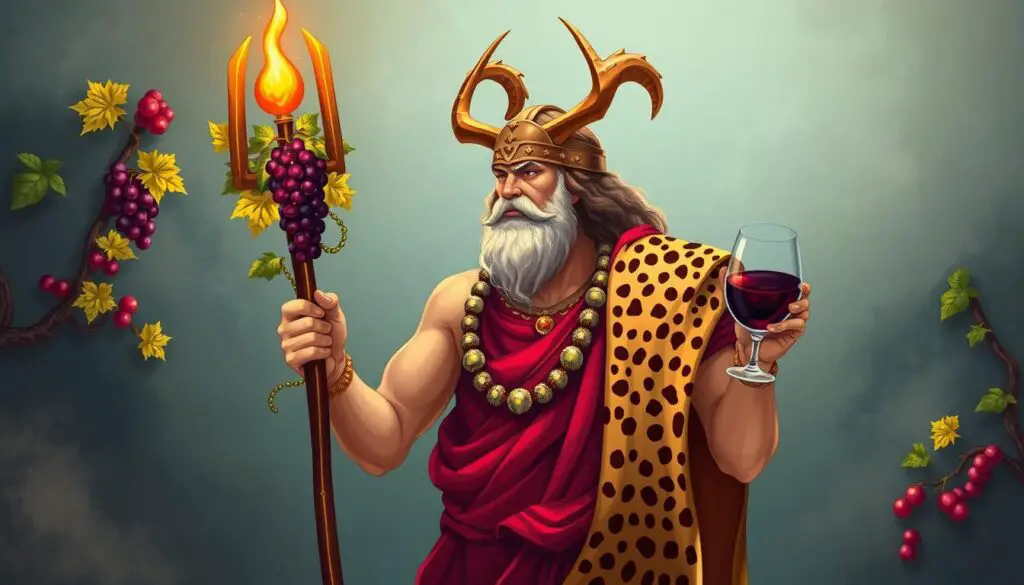
Dionysus, the Greek god of wine, revelry, and ecstasy, was often depicted in ancient art and iconography with a rich array of symbols and attributes reflecting his divine powers.
From the iconic wine goblet (kantharos) to the grapevine and the thyrsus (a fennel-stem scepter tipped with ivy and dripping with honey), these visual representations offer insights into the multifaceted nature of this captivating deity.
Wine, Grapevines, and the Thyrsus
As the god of wine, Dionysus is inextricably linked to the grapevine, a symbol of fertility, abundance, and the transformative power of fermentation.
The thyrsus, a staff entwined with ivy and topped with a pine cone, was a hallmark of Dionysian rites and processions, representing the god’s role as a bringer of ecstasy and mystical inspiration.
Animals and Bestial Forms
Dionysus’s iconography also features various animals, each with its symbolic significance.
The bull, panther, tiger, goat, and snake all played a role in the god’s dual nature, embodying both his civilized and wild aspects.
These bestial forms underscored Dionysus’s power to induce ecstasy, madness, and transformation in his followers.
The rich symbolism and iconography associated with Dionysus reflect the multifaceted aspects of this ancient Greek deity, whose influence extended far beyond the realm of wine and revelry into the realms of theater, fertility, and the mysteries of life and death.
Transition to the Roman Bacchus
In Roman religion, the Greek god Dionysus was identified with the deity Bacchus, also known as Liber Pater, the “Free Father” of the Liberalia festival.
While the Roman state initially viewed the independent, popular festivals of Bacchus (the Bacchanalia) as subversive, they were eventually merged with the more toned-down and state-approved celebrations of Liber and Dionysus.
The Bacchanalia were ancient Roman festivals initially dedicated to Bacchus, the god of wine.
These celebrations evolved from private gatherings to broader, more frequent events over time.
However, the crackdown by the Roman Senate in 186 BC significantly limited and regulated these festivals, emphasizing the importance of oversight.
The Bacchanalia transitioned from exclusive women-only events to more inclusive celebrations for both men and women, marking a significant cultural shift in these religious practices.
The Bacchanalian scandal of 186 BC involved thousands of individuals in secretive and illicit activities, leading to arrests and executions.
The Roman Senate’s decree banned Bacchanalian practices and imposed restrictions on future religious gatherings, reshaping public perceptions of mystery cults as potentially subversive elements in Roman society.
Despite the initial suppression, the Roman cult of Bacchus continued to evolve, with the deity eventually being integrated into the state-sanctioned celebrations of Liber and Dionysus.
This transition demonstrates the resilience and adaptability of the Roman Bacchus, who remained a significant figure in the religious and cultural landscape of the Roman world.
Influence on Art and Literature
Dionysus, the captivating Greek god of wine, revelry, and theater, had a profound impact on the artistic and literary traditions of ancient Greece.
His myths, symbols, and festivals played a central role in shaping the cultural landscape of the era, leaving an indelible mark on the creative expressions of the time.
The performance of tragedy and comedy in Athens was intrinsically linked to the festivals dedicated to Dionysus, known as the Dionysia.
These theatrical productions, which explored the depths of the human experience, drew heavily on the god’s themes of transformation, ecstasy, and the duality of human nature.
Dionysus’s iconography and mythological narratives were also popular subjects for vase painting and other forms of ancient Greek art.
Beyond the stage and canvas, Dionysus inspired the creation of lyrical poems called dithyrambs, further solidifying his importance in the cultural and artistic development of ancient Greek civilization.
These poetic works, often performed at Dionysian festivals, celebrated the god’s power to inspire ecstatic revelry and spiritual transformation.
Dionysus’s enduring influence can be seen in the continued relevance of his themes and symbolism in modern art and literature.
Contemporary artists, writers, and thinkers continue to draw upon the Dionysian motifs of liberation, creativity, and the transformative power of ritual and art, further underscoring the lasting impact of this captivating Greek deity.
Rebirth and Orphic Legends
In the captivating realm of Greek mythology, the story of Dionysus, also known as Zagreus, offers a fascinating glimpse into the concept of rebirth and the intricate Orphic legends.
This twice-born god, the son of Zeus and Persephone, was a central figure in the Orphic mysteries, a set of beliefs and rituals that significantly influenced the spiritual and cultural landscape of ancient Greece.
Zagreus and the Titans
According to Orphic tradition, the infant Zagreus/Dionysus was torn to pieces by the evil Titans, a savage act of violence that shook the divine realm. However, this tragic dismemberment was not the end of the story.
Athena saved the god’s heart, and Zeus, in a powerful display of divine retribution, struck the Titans with lightning. From the ashes of the Titans, the first humans emerged, possessing both the evil nature of their progenitors and the divine essence of the gods.
This myth of the god’s dismemberment and subsequent resurrection was central to the Orphic concept of the cyclical nature of life and death.
It highlighted the belief that the human condition was a reflection of the divine, with both the darkness and light of the cosmos intertwined within us.
The Orphic tradition emphasized the idea of purification and the attainment of spiritual enlightenment, as a means to transcend the limitations of the physical body and embrace the eternal cycle of rebirth.
The Orphic legends surrounding Dionysus/Zagreus not only captivated the ancient Greek imagination but also left an indelible mark on the cultural and philosophical landscape.
These rich mythological narratives continue to fascinate scholars and enthusiasts alike, shedding light on the complex and multifaceted nature of this enigmatic deity, whose rebirth and transformation embodied the very essence of the human experience.
Conclusion
Dionysus, also known as Bacchus, was a remarkably complex and multifaceted deity in Greek mythology, representing a wide range of concepts and powers – from wine and fertility to ritual madness and theatrical performance.
His cult and myths were deeply rooted in ancient Greek culture, with evidence of his worship dating back to the Mycenaean period.
Dionysus’s enduring legacy can be seen in his profound influence on art, literature, and religious practices throughout the classical world and beyond.
From the vibrant mosaics of ancient cities like Antiocheia and Zeugma, which often depicted Dionysus’s relationship with Ariadne, to the celebrated wedding ceremonies of the god and his divine consort, Dionysus’s presence is evident in numerous artistic and cultural expressions of the era.
As the chapter “Conclusion” in the book “Dionysus after Nietzsche” suggests, the study of this captivating deity continues to hold important implications for the discipline of Classics, calling for a reorientation towards a less historicist understanding of the ancient past in the spirit of Nietzsche’s Greeks. Dionysus’s complex and multifaceted nature, as well as his enduring influence, make him a subject of enduring fascination and scholarly exploration.
Frequently Asked Questions
Q: What was Dionysus famous for?
Dionysus is famous for being the Greek god of wine, winemaking, grape cultivation, fertility, ritual madness, theater, and religious ecstasy. His festivals were the driving force behind the development of Greek theater and were characterized by their ecstatic and chthonic aspects.
Q: Is Aura a nymph?
No, Aura is not a nymph. She is a Titaness, known for her virginity and as a personification of the breeze.
Q: What did Zeus do to Dionysus?
Zeus saved Dionysus from the wrath of Hera by sewing him into his thigh until he reached maturity, after his mother, Semele, perished from seeing Zeus’s true form.
Q: Why was Dionysus killed?
In one myth, Dionysus was killed and dismembered by the Titans at the instigation of Hera. Zeus struck the Titans with lightning, and from the ashes of the destroyed Titans, humanity was born, containing a portion of Dionysus’ divine nature.
Q: Is Dionysus an evil god?
Dionysus is not typically considered evil; rather, he embodies both the benevolent and destructive aspects of nature, representing the duality of wine which can bring both joy and reckless abandon.
Q: What bad thing did Dionysus do?
Dionysus is known for driving mortals to madness if they disrespected him or denied his divinity, as shown in the story of King Pentheus of Thebes who opposed his worship and was torn apart by his own mother in a Dionysian frenzy.
Q: How are Dionysus and Jesus similar?
Some scholars note similarities between Dionysus and Jesus Christ, such as stories of turning water into wine, their roles as divine figures of resurrection, and symbolic associations with life after death.
Q: Why did Dionysus go insane?
Dionysus went insane as a young god when Hera, jealous of his mother, cursed him. In his madness, he wandered various parts of the world until being cured by Rhea, his grandmother.
Q: Who was Dionysus’ male lover?
Dionysus had several male lovers, one of the most notable being Ampelos, a satyr whose death was mourned by Dionysus and led to the creation of the first grapevine.


